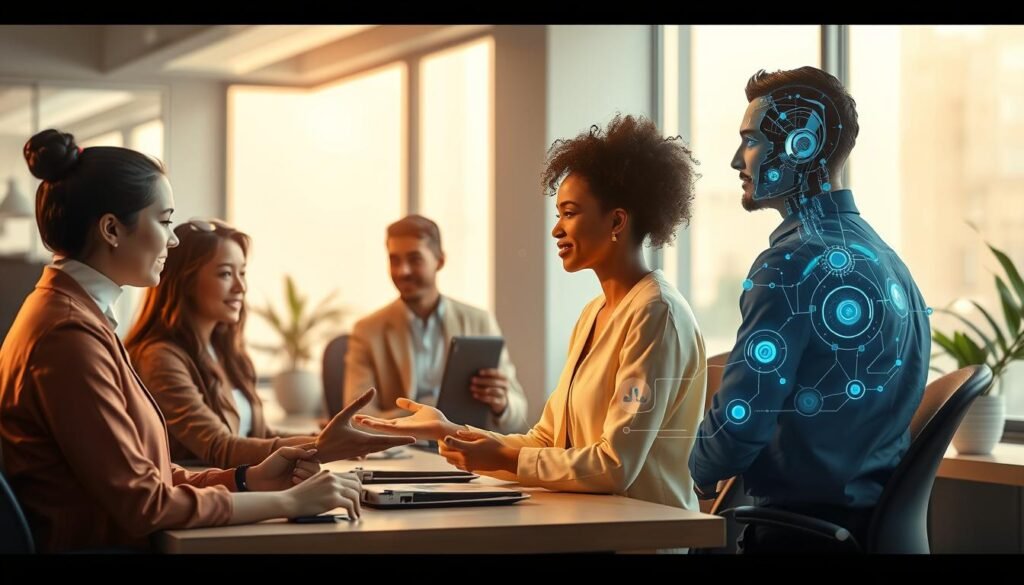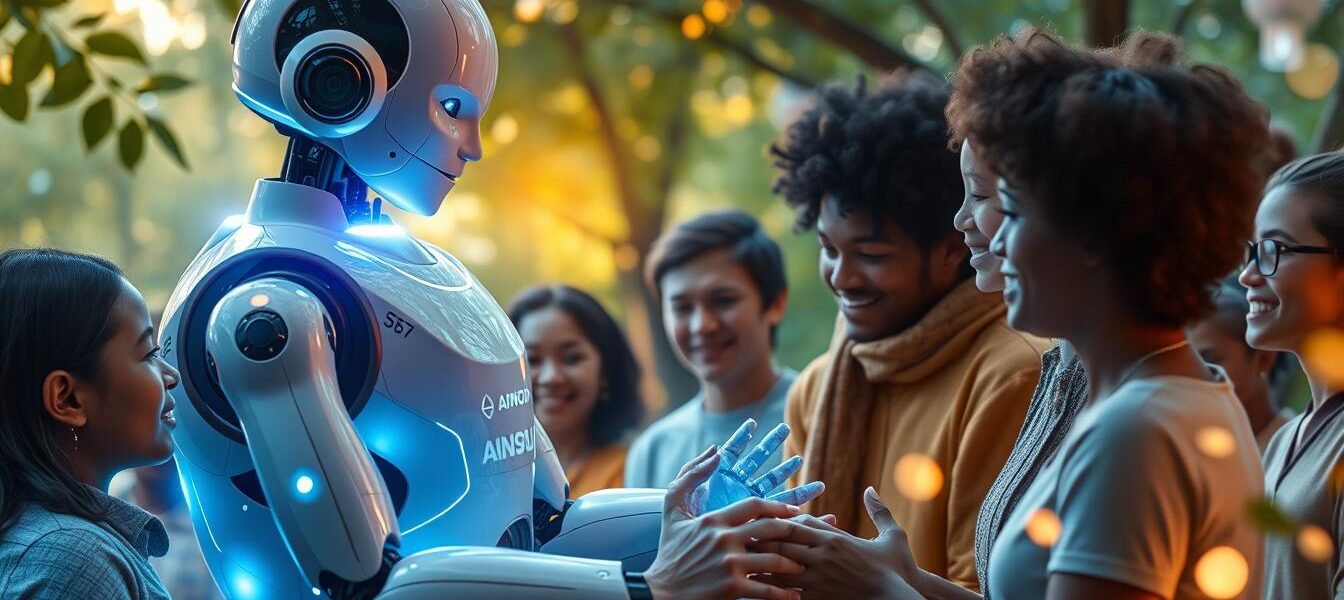We’re on the edge of a big tech change. It makes me wonder: Can AI really get our feelings and build real connections? In a world where we often feel alone, AI could be key to bringing us closer. Let’s look into how AI can help us feel more connected and kind towards each other.
By adding emotional smarts to AI, we can change how we talk and interact. This could lead us to a world that’s more caring. I invite you to come along as we explore this idea.
Key Takeaways
- The integration of emotional intelligence into AI systems is crucial for fostering empathy and compassion.
- Understanding human emotions is essential for developing empathy-focused AI applications.
- AI has the potential to revolutionize societal interactions, offering deeper connections.
- Designing AI with a focus on empathy can lead to positive societal changes.
- The relationship between technology and empathy is an evolving narrative that requires exploration.
The Importance of Empathy in Technology
Empathy is key to building strong human connections. It means understanding and feeling what others feel. This makes relationships better in many areas, not just with people we know.
It also helps with technology, making communication clearer and building bonds with different groups of people.
Understanding Empathy in Human Interactions
In today’s busy life, empathy is more important than ever. People want real connections and to feel understood. Sharing feelings helps us get closer and be more compassionate.
This makes our relationships stronger and our work together better. When making technology, adding empathy can make it better for users.
How Technology Can Enhance Human Relationships
Technology can change how we connect, even if we’re far apart. Technology for empathy lets us talk and share feelings easily, breaking down barriers. Video calls, team tools, and social media help us connect and support each other.
Studies in healthcare show how empathy in tech makes care better. It shows empathy’s big role in many areas, thanks to technology.
| Element | Effects on Human Interactions |
|---|---|
| Empathy | Fosters connection, understanding, and trust |
| Technology | Bridges gaps, enhances communication, strengthens relationships |
| Combination | Creates a supportive environment for interaction |
Understanding Artificial Intelligence
In recent years, I’ve looked into what artificial intelligence means. It’s a field that changes our daily lives a lot. AI are systems that do tasks that usually need human smarts, like making decisions, learning, and solving problems. Knowing what AI is helps me see how it changes many areas.
Defining Artificial Intelligence
Understanding AI means looking at its tech parts and its big picture. AI uses algorithms and data to act like our brains. It finds patterns and solves tough problems. This has changed many industries, making things smarter and helping with decisions.
The Role of AI in Modern Society
AI changes how we work, talk, and even meet each other. In healthcare, AI helps make patients better off. Schools use AI for learning that fits each student’s needs. Businesses use AI to improve customer service and make things run smoother, building stronger bonds with customers. For more on AI’s big changes, AiNosu.com is a great source.

| Field | AI Applications | Empathy Solutions |
|---|---|---|
| Healthcare | Predictive diagnostics | Emotionally aware support systems |
| Education | Adaptive learning platforms | Personalized learning experiences |
| Customer Service | Chatbots and virtual assistants | AI-powered feedback systems |
The Potential of AI to Foster Empathy and Compassion
Technology has made huge strides, leading to AI that does more than just process information. I’ve seen how this tech can deeply understand human feelings. This opens up a new chapter in how we talk to each other with compassion.
Thanks to machine learning, AI can now pick up on and respond to our emotions. This is creating empathy in ways we never thought possible.
AI’s Capabilities in Emotional Understanding
AI is making great strides in understanding emotions. It uses deep learning and natural language processing to spot and make sense of emotional signs. This lets AI have conversations that feel real and supportive.
Applications of AI in Compassionate Communication
Compassionate communication is key in many areas, like mental health support. AI tools offer empathetic answers to help people work through tough emotions. For example, chatbots can mimic talks with experts, giving support to those who need it.
I believe these technologies will help close emotional gaps. They will make our connections with each other stronger.
| Application | Description | Benefits |
|---|---|---|
| Therapeutic Chatbots | AI tools providing mental health support through conversations. | Improves accessibility to care, reduces wait times. |
| Virtual Support Groups | Online platforms powered by AI facilitating empathetic discussions. | Creates safe spaces for sharing experiences and emotional support. |
| Emotion Recognition Software | AI systems that analyze voice tones and facial expressions. | Enhances situational awareness in critical care settings. |
AI Tools for Promoting Empathy and Compassion
In today’s fast-changing world, AI tools are key to boosting our empathy and compassion. They use technologies like natural language processing and sentiment analysis. These tools help us understand human feelings and connect with different people.
Natural Language Processing for Empathy
Natural language processing (NLP) is crucial for AI that understands emotions. It lets machines get what we mean from our words, making conversations more meaningful. For example, NLP helps teachers talk better with students from various backgrounds.
It gives educators tools to connect with students, especially those who might feel left out.
Sentiment Analysis and Its Impact on Compassion Building
Sentiment analysis goes deeper by spotting emotional signals in language. This AI tool looks at how people show their feelings. In schools, it helps teachers see how students feel and what they need.
For example, it can change lessons to match what students are going through. If you’re curious about AI and empathy in schools, check out this in-depth article. It shows how AI can make classrooms more caring.

AI in Education: Fostering Empathy in Classrooms
AI in education is changing how we learn, making classrooms more empathetic. It helps teachers understand what each student needs. This leads to more caring and supportive learning spaces.
AI-Powered Learning Environments
AI makes learning fun and interactive. It changes the content to fit each student’s level. This way, everyone gets the help they need.
AI also watches for signs that a student might be struggling or losing interest. Teachers can then step in to help. This makes learning more personal and caring.
Using AI to Understand Diverse Student Needs
AI helps teachers see what each student needs. It looks at how they learn, feel, and interact with others. This info helps teachers create a supportive classroom.
Tools like IBM Watson Education show how AI can help teachers. They understand their students’ challenges better. This leads to teaching that is more caring and effective.
| AI Application | Description | Benefits |
|---|---|---|
| Adaptive Learning Systems | Personalizes lessons based on student performance. | Enhances learning by addressing individual strengths and weaknesses. |
| Emotion Recognition Software | Analyzes student emotions through facial recognition and voice cues. | Enables timely interventions to support emotional well-being. |
| Data Analytics Tools | Assesses learning patterns and preferences. | Supports targeted teaching strategies and resource allocation. |
AI in education does more than just meet student needs. It also builds empathy in classrooms. This creates a well-rounded education that cares for the whole student.
AI Solutions for Compassion Development in Healthcare
AI is changing healthcare, making doctors give better care to patients. It helps improve patient experiences with kind responses. As healthcare changes, AI gives doctors valuable insights. This lets them give care that’s just right while keeping empathy.
The Role of AI in Patient Care
AI helps doctors focus on what each patient needs. For example, AI looks at symptoms and past treatments to suggest the best care. This way, doctors can help with both physical and emotional health.
This makes the bond between doctors and patients stronger. It’s supported by AI’s data-driven insights.
Training AI for Compassionate Responses
Training AI to be kind is key for good patient care. Adding emotional smarts to AI helps it connect with people like a human would. Through careful training, AI learns to pick up on emotions and react right.
This training uses data that shows many different feelings and healthcare situations.

With the right training, AI can be a big help. It can do more than just diagnose; it can show care and listen to patients. For this to work, everyone must support using tech that cares about feelings.
| AI Application | Impact on Patient Care | Examples |
|---|---|---|
| Predictive Analytics | Identifies at-risk patients | Alert systems for chronic diseases |
| Chatbots | Offers immediate support and information | Symptom checkers |
| Telemedicine | Improves access to healthcare | Virtual consultations |
Looking at AI’s growth, we see a big chance to make healthcare better. By focusing on kind responses and proper AI training, we can make patient care brighter. This means technology and empathy will work together on this path.
AI For Foster Empathy and Compassion
In today’s world, using AI to boost empathy is key. Technology can help us understand and care for each other better. By using AI, we can make systems that help us connect on a deeper level.
How AI Can Bridge Emotional Gaps
AI is a powerful tool for closing emotional gaps between people. It can understand interactions and give insights to improve how we feel about each other. This makes our conversations more meaningful.
It can also tell when someone is feeling something they can’t say out loud. This helps us build stronger connections and support each other better.
Innovative AI Solutions for Fostering Empathy
Many projects show how AI can help us be more empathetic. Chatbots can pick up on emotions, making online chats feel real. Platforms that use our data can send messages that really speak to us.
To learn more about how our data is used, check out the privacy policy of websites collecting our information. It tells us how our data is protected. These efforts show how AI can bring us closer together, building a caring community.
Real-World Examples of Empathetic AI Applications
Today, emotional intelligence in tech makes user experiences better. Many companies use empathetic AI to make customer service more caring. This changes how we interact and builds stronger bonds. Here are some examples of how AI meets emotional needs effectively.
AI in Customer Service: Enhancing User Experience
AI has made customer service better by understanding feelings. Chatbots and virtual assistants now know how customers feel and respond accordingly. This makes users feel like they’re getting personal and caring service. Brands like Zendesk and Salesforce use AI to help reps give more compassionate support.
Case Studies of Compassionate AI Implementations
“AI-driven tools can help bridge gaps in emotional communication, making service interactions truly memorable.” – Technology Analyst
Looking at real examples, I found some standout cases:
| Company | AI Application | User Experience Improvement |
|---|---|---|
| Lyft | AI-driven feedback analysis | Enhanced driver-passenger communication, showing empathy in service quality |
| Sephora | Virtual artist AI | Personalized shopping experiences based on customer preferences and moods |
| Hootsuite | Sentiment analysis tools | Understanding customer emotions through social media engagement |
These examples show how empathetic AI in customer service improves emotional connections. It’s a move towards more caring service, which builds loyalty and satisfaction.

The Role of AI in Customer Experience Management
AI is key in making customer experiences better by giving businesses the tools for smooth interactions. It helps companies get insights that make customers happier and more loyal.
AI-Driven Insights for Better Customer Interactions
AI gives businesses deep insights that help them know what customers like and do. By looking at data from different places, companies can make their products better. This leads to more people enjoying their products and being happier.
Empathy in Automated Customer Support
Automated customer support has changed how companies talk to their customers. AI can handle simple questions well, but it’s hard to keep it empathetic. It’s important to mix in real human touch, especially for tricky issues.
To fix this, AI can be made to understand feelings and emotions. This makes automated help feel more like talking to a person. Using AI in customer experience management helps make sure automated responses are more caring.
Ethical Considerations in AI Development for Empathy
When we talk about using artificial intelligence to make us more empathetic, we must think about the ethical sides. We need to look closely at how these technologies affect people. It’s important to keep a balance between making things more efficient and keeping human touch real.
As we move forward with AI, I promise to keep ethical use at the heart of our work.
Balancing Efficiency and Human Connection
AI has made many things more efficient, but we can’t let that forget the human side. I want to find ways to keep the mix of machine power and human feelings. It’s hard to know when a tech fix might hurt real human connections.
We need to be careful to make sure AI doesn’t take away from our true interactions. This means finding a way to use AI that keeps empathy in our talks.
Guidelines for Ethical AI Use in Compassion Initiatives
It’s crucial to have clear rules for using AI ethically in compassion projects. A strong set of rules can tackle privacy, freedom, and making sure AI doesn’t discriminate. These rules help make sure AI helps people more.
Understanding these rules is important for me. They guide how AI should be used, especially when it comes to empathy. You can find more about these rules here.
| Guideline | Description |
|---|---|
| Privacy | Ensuring user data is protected and handled with care. |
| Non-Discrimination | Promoting fairness in AI outcomes to avoid bias. |
| Autonomy | Allowing users to maintain control over their personal information. |
| Beneficence | Acting in ways that benefit users and promote well-being. |
| Empathy | Embedding empathetic responses into AI interactions. |
| Environmental Considerations | Addressing the environmental impact of AI technology. |
By understanding these guidelines, I’m committed to pushing for AI that values human connection. It also protects our rights and dignity.

Future Directions for AI and Empathy Research
Looking ahead, I see exciting chances for AI to improve our grasp of empathy and compassion. Research is showing us new ways AI can connect with humans. These advances boost emotional smarts and open doors to new uses in many fields.
Emerging Trends in AI Technology
The future of AI is full of new trends, like better algorithms for understanding feelings and learning from us. Technologies like deep learning and neural networks are changing how AI reads our emotions and social signals. These changes will make AI systems more aware and empathetic in how they interact with us.
Some key trends to watch include:
- AI that changes to match our feelings in real-time.
- Better ways to understand what people need through sentiment analysis.
- AI that works with us, learning from our actions for better service.
The Importance of Continuous Learning in AI
Continuous learning is key for AI to stay relevant in a fast-changing world. As feelings and situations change, AI must keep up with new data and contexts. This means it needs to learn throughout its life to stay a useful tool for compassion and empathy.
Investing in ongoing learning helps AI:
- Get better at recognizing emotions.
- Make interactions more personal.
- Gain trust by meeting user expectations.
Those looking to use AI wisely should check out this resource. It talks about how to use AI ethically.

Challenges in Designing Empathetic AI Systems
Creating AI that feels like it understands us is hard for developers. They face many hurdles on the way to making AI that really gets human feelings. This part talks about these challenges and why it’s key to fix biases in AI to make it fair and just.
Limitations of Current AI Technology
AI has made big strides, but it still can’t quite get how we feel. Here are some of the issues it faces:
- It can’t pick up on subtle emotional signs, which leads to misunderstandings.
- It often misses the context, which can mess up decisions in important talks.
- Keeping an emotional connection over time is hard for AI.
Addressing Biases in AI Training Data
It’s vital to fix biases in the data that trains AI. If the data is biased, the AI will be too. Here are some ways to tackle this:
- Use diverse data that shows a broad range of human experiences.
- Check AI systems often to spot and fix any biased answers.
- Make ethics and fairness a big part of designing AI from the start.

How to Implement AI for Empathy and Compassion in Organizations
Adding AI to an organization can make the workplace better and more efficient. To make AI work well, follow a clear plan. This plan includes several important steps.
Steps for Effective AI Integration
Here’s a guide to help you use AI to build empathy:
- Identify Needs: Find out where in your company AI can help with empathy.
- Engage Stakeholders: Talk to important people early to get their ideas and work together.
- Choose the Right Technology: Pick AI tools that help with emotional smarts and kind interactions.
- Develop a Training Program: Teach employees how AI can help build empathy.
- Monitor Outcomes: Check how AI affects employee happiness and customer happiness.
- Refine Strategies: Use what you learn to make things better over time.
Case Examples of Successful AI Adoption
Real examples show how AI can make empathy work:
| Organization | AI Tool Used | Impact on Empathy |
|---|---|---|
| Salesforce | Einstein AI | Improved customer interactions, building a more personalized experience. |
| IBM | Watson Assistant | Improved patient care communication in healthcare, resulting in better understanding of patient needs. |
| Zendesk | Answer Bot | Streamlined customer support, leading to increased customer satisfaction and empathy. |

Conclusion
Looking back at the journey of AI and empathy, it’s clear that making AI compassionate is vital. These technologies can boost emotional smarts in society. This leads to better interactions and a more welcoming place in our groups and communities.
AI tools that understand human feelings and actions help us make places where empathy is key. I see AI changing leadership and how we connect with each other for the better. It shows how AI can help us build a kinder future.
AI’s growth could change how we see and connect with each other. With careful use, AI can be a positive force, helping us stay connected on a deeper level. For more on how AI helps us connect, check out this article. It talks about empathy in the digital world.





